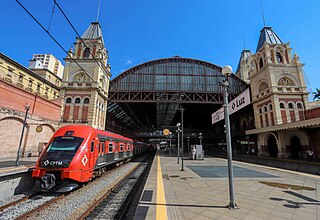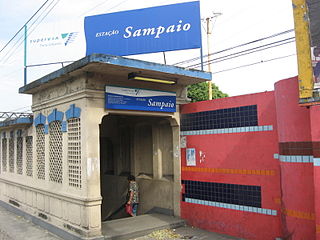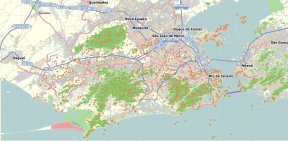
The Rio de Janeiro Metro, commonly referred to as just the Metrô is a rapid transit network that serves the city of Rio de Janeiro, Brazil. The Metrô was inaugurated on 5 March 1979, and consisted of five stations operating on a single line. The system currently covers a total of 58 kilometres (36 mi), serving 41 stations, divided into three lines: Line 1 ; Line 2, which together travel over a shared stretch of line that covers 10 stations of an approximate distance of 5 kilometres (3.1 mi); and Line 4. Metrô Rio has the second highest passenger volume of the metro systems in Brazil, after the São Paulo Metro.

The Estrada de Ferro Central do Brasil was one of the principal railways of Brazil, uniting the states of Rio de Janeiro, São Paulo and Minas Gerais.

SuperVia Trens Urbanos is a rapid transit and commuter rail company operator, founded in Rio de Janeiro (Brazil) in November 1998. It carries around 750,000 passengers a day on a railroad network comprising 104 stations in 12 cities: Rio de Janeiro, Duque de Caxias, Guapimirim, Nova Iguaçu, Nilópolis, Mesquita, Queimados, São João de Meriti, Belford Roxo, Japeri, Paracambi and Magé.

Rail transport in Brazil began in the 19th century and there were many different railway companies. The railways were nationalized under RFFSA in 1957. Between 1999 and 2007, RFFSA was broken up and services are now operated by a variety of private and public operators, including Rumo Logística, Companhia Paulista de Trens Metropolitanos and SuperVia.

Méier is a middle class and upper middle class neighborhood in the North Zone of Rio de Janeiro, Brazil. The neighborhood is the historic center of the "Área dos Engenhos", or "Mill Area", which today is known as Grande Méier and has been a sub-prefecture since 2013. As a result, it has a wide range of shops and a variety of services and transport, although it is not one of the largest neighborhoods of the municipality. In the neighborhood is located one of the first shopping centers in Brazil, Shopping do Méier, opened in 1963. It has two distinct urban appearances, one more bustling, commercial, in the areas close to the train station, and a quieter one, on more residential streets.

The Santa Teresa Tram, or Tramway, is a historic tram line in Rio de Janeiro, Brazil. It connects the city's centre with the primarily residential, inner-city neighbourhood of Santa Teresa, in the hills immediately southwest of downtown. It is mainly maintained as a tourist attraction and is nowadays considered a heritage tramway system, having been designated a national historic monument in 1985. The line has a very unusual gauge: 1,100 mm. The main line is 6.0 kilometres long.
The Rio–São Paulo High-Speed Rail is a planned high-speed rail project to connect São Paulo and Rio de Janeiro. While originally planned to be operational by 2014 in time for the 20th FIFA World Cup, to be held in Brazil at a cost of $9 billion, as of May 2015 formal bidding for the project had yet to start, with the Brazilian government delaying the auction by "at least" one year in August 2013, pushing back hopes of completion to at least the 2020s.

Engenho Novo is a neighborhood of middle class and lower middle of the North Zone of Rio de Janeiro, Brazil.

São Cristóvão Station is a railway station in São Cristóvão, Rio de Janeiro which is serviced by the Rio de Janeiro Metro and SuperVia.

Mangueira is a railway station in Mangueira, Rio de Janeiro which is serviced by the Supervia.

Praça da Bandeira Station, previously known as Lauro Müller Station, is a railway station in Praça da Bandeira, Rio de Janeiro which is serviced by the Supervia.

São Francisco Xavier is a railway station in São Francisco Xavier, Rio de Janeiro which is serviced by the Supervia.

Riachuelo, originally known as Riachuelo do Rio, is a railway station in Riachuelo, Rio de Janeiro which is serviced by the Supervia.

Sampaio is a railway station in Sampaio, Rio de Janeiro which is serviced by the Supervia.

Méier is a railway station in Méier, Rio de Janeiro which is serviced by the Supervia.
The Deodoro Line is a commuter rail line operated by SuperVia as part of the Rio de Janeiro Metropolitan Trains system. It runs from Deodoro, in the West Zone of Rio de Janeiro, through the North Zone to Central do Brasil Station, in Rio de Janeiro Downtown. The route and stations are shared with the Santa Cruz and Japeri Lines. It's the busiest line in the system. Since June 2020, it has been interconnected with the Santa Cruz Line.
Santa Cruz Line is a commuter rail line operated by SuperVia. It is a shortening of the old Mangaratiba Branch of Central do Brasil Railway, as this line continued towards the extinct Mangaratiba station, in the homonymous city, located in the coastal region of Costa Verde.
The Japeri Line is a commuter rail line operated by SuperVia.

The São Paulo Metropolitan Train is a public transit rail system implanted in Greater São Paulo, serving 23 of its 39 municipalities. It has 273 km (170 mi) of length, 7 lines and 94 stations, transporting approximately 3 million passengers per day. Currently, it is operated by the state-owned company Companhia Paulista de Trens Metropolitanos (CPTM), but two of the lines were auctioned to ViaMobilidade, which began operating their administrations in January 2022.

Ferrovia Paulista S/A (FEPASA) was a São Paulo state-owned freight and passenger railway company, created by merging Paulista Railroads Company (CPEF), Mogiana Railroads Company (CMEF), Sorocabana Railroad (EFS), Araraquara Railroad (EFA), and São Paulo-Minas Railroad (EFSPM). It remained in activity from October 1971 until May 1998, when it was extinguished and incorporated into the Federal Railway Network S/A (RFFSA).

















